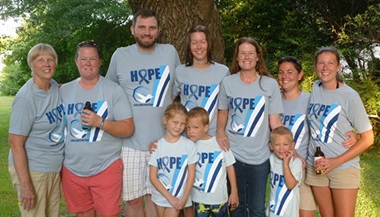Basal Cell Nevus Syndrome (Gorlin Syndrome)
The risk for ovarian tumors and skin cancer is increased with basal cell nevus syndrome (also called Gorlin syndrome or nevoid basal cell carcinoma), a rare autosomal dominant cancer genetic syndrome. Features associated with basal cell nevus syndrome may include the following:
-
Development of more than 2 basal cell carcinomas (cancer of the outer layer of the skin) before the age of 20
-
Cysts in the jaw
-
Characteristic facial appearance
-
Calcification of the falx (a variation in the appearance of the skull that is visible on X-rays)
-
Pits in the palms and soles of the feet
-
Macrocephaly (enlarged head size)
-
Rib or vertebral abnormalities
-
Increased risk of medulloblastoma (malignant brain tumor) during childhood
-
Increased risk of cardiac or ovarian fibromas (benign, or noncancerous, tumors)
Basal cell nevus syndrome is caused by changes in a tumor suppressor gene, called PTCH1. This gene is located on chromosome 9. Mutations in this gene may increase the risk of some cancers.
Molecular genetic testing of PTCH1 is available on a clinical basis.
Tumor suppressor genes usually control cell growth and cell death. Every person is born with two copies of each tumor suppressor gene, one inherited from his or her mother and one from his or her father. Both copies of a tumor suppressor gene must be altered, or mutated, before a person may develop cancer. With basal cell nevus syndrome, the first mutation is inherited from either the mother or the father. This happens in 70% to 80% of cases. In 20% to 30% of cases, the first mutation is not inherited. It arises for the first time (de novo) in the affected person. Whether de novo or inherited, this first mutation is present in all of the cells of the body from conception. It is called a germline mutation.
Whether a person who has a germline mutation will develop cancer and where the cancer(s) will develop depends on where (which cell type) the second mutation happens. For example, if the second mutation is in the skin, then skin cancer may develop. If it is in the ovary, then ovarian cancer may develop. The process of tumor development actually needs mutations in multiple growth control genes. Loss of both copies of PTCH1 is just the first step in the process. What causes these additional mutations is unknown. Possible causes include chemical, physical, or biological environmental exposures (such as sunlight) or chance errors when cells copy themselves.
Some people who have inherited a germline tumor suppressor gene mutation may never develop cancer. This is because they never get the second mutation necessary to knock out the function of the gene and start the process of tumor formation. This can make the cancer appear to skip generations in a family. But, in reality, the mutation is present. People with a PTCH1 mutation, regardless of whether they develop cancer, have a 50/50 chance to pass the mutation on to each of their children.
It is also important to remember that the gene responsible for basal cell nevus syndrome is not located on the sex chromosomes. Therefore, mutations can be inherited from the mother's side or the father's side of the family.
If you have a family history of cancers, discuss this with your healthcare provider and ask if you should be screened for a familial cancer syndrome and screened for the development of certain tumors.





